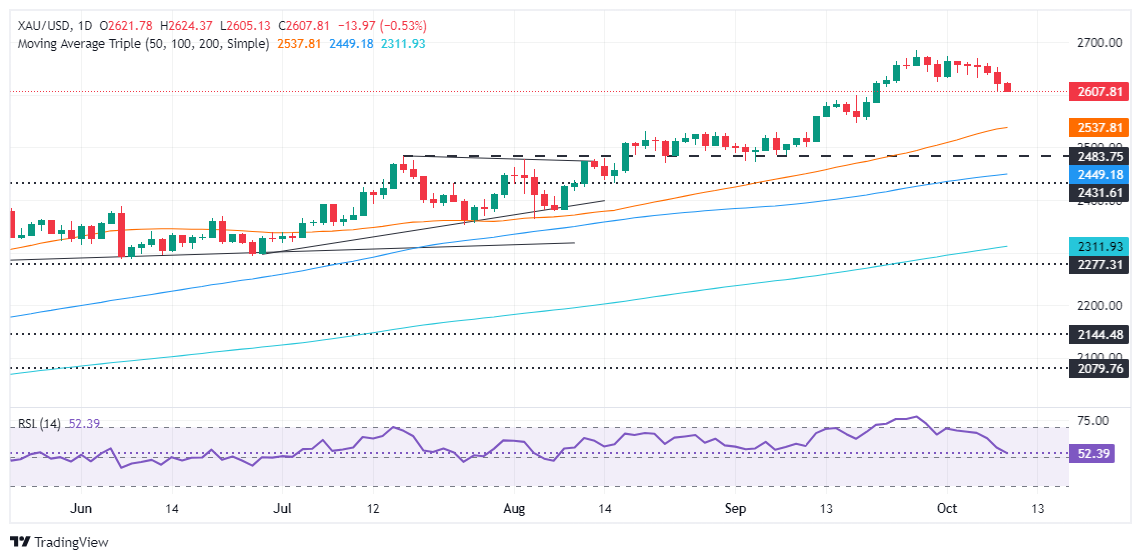- Gold fell as the Fed minutes revealed that a “substantial majority” supported a 50bp cut, while some preferred 25bp.
- The CME FedWatch tool shows lower odds of a 25bp cut, dropping to 75.9%, with rising expectations of a rate pause.
- The 10-year US Treasury yield rises to 4.062%, supporting the US Dollar.
- Traders await Thursday’s CPI data for more direction on inflation and Fed policy.
Gold extended its losses for the sixth consecutive day after the Federal Reserve (Fed) revealed the minutes of its September meeting. The minutes showed that the “substantial majority” of the Federal Open Market Committee (FOMC) supported a 50 basis point (bp) cut. Despite this, XAU/USD is trading at familiar levels near $2,610, down more than 0.37%.
The FOMC minutes showed that some officials would have preferred a 25 bp cut, although all participants favored lowering interest rates. As for the Fed’s dual mandate in both cases, nearly all officials saw inflation risks tilted to the downside, while labor market risks were tilted to the upside.
Following the data, the CME FedWatch tool shows that the odds of a 25 bp interest rate cut decreased from 85.2% yesterday to 75.9%. This means that some market participants positioned themselves towards the Fed keeping rates unchanged, with odds of 24.1%, up from 14.8% on Tuesday.
US Treasury yields continued to rise with the 10-year Treasury note at 4.062%, up five and a half basis points. This supported the Dollar, which according to the US Dollar Index (DXY) rose 0.42% to 102.90, its highest level since mid-August 2024.
Now, traders’ attention is focused on the release of the US Consumer Price Index (CPI) on Thursday. Estimates suggest that inflation will continue to trend downward. However, if inflation turns out to be higher than estimated, it will open the door for a pause in the Fed’s easing cycle.
The US economic calendar for the week will include US inflation, US employment data and Fed speeches.
Daily Market Summary: Gold Prices Pressured by FOMC Minutes Ahead of US CPI
- The US CPI is expected to decline from 2.5% to 2.3% year-on-year. The monthly CPI is projected to be 0.1%, down from 0.2%.
- The core CPI is expected to remain unchanged compared to the August figure at 3.2% year-on-year. The September figure is estimated to drop from 0.3% to 0.2% monthly.
- Other data will reveal initial jobless claims for the week ending October 5. Projections suggest 230,000 new people filed for unemployment benefits, up from the previous reading of 225,000.
- After Friday’s NFP report, Fed officials are more cautious. Vice President Philip Jefferson said his approach is “meeting by meeting” and data-driven. Boston Fed President Susan Collins expects more rate cuts, also based on incoming data.
- Following the latest US jobs report, recession fears faded. Therefore, most Wall Street banks such as Citi, JPMorgan and Bank of America revised their Fed forecast for November from a 50 to 25 bp cut.
- Meanwhile, the People’s Bank of China (PBoC) paused its bullion purchases for the fifth month. China’s reserves were unchanged at 72.8 million troy ounces at the end of last month.
XAU/USD Technical Analysis: Gold Price Falls as Sellers Target Support Below $2,650
Gold prices extended losses below $2,630 and fell to a daily low of $2,605 as traders digested the minutes of the September FOMC meeting.
Short-term momentum is bearish although the Relative Strength Index (RSI) is showing mixed readings and is in bullish territory.
XAU/USD has fallen below $2,620. A break of $2,600 will expose the psychological mark of $2,550 ahead of the 50-day SMA at $2,537. Once these levels are surpassed, the next figure is $2,500.
On the contrary, if gold points higher and reclaims $2,650, it will pave the way to challenge $2,670 before the yearly high of $2,685.
Gold FAQs
Gold has played a fundamental role in human history, as it has been widely used as a store of value and medium of exchange. Today, apart from its brilliance and use for jewelry, the precious metal is considered a safe-haven asset, meaning it is considered a good investment in turbulent times. Gold is also considered a hedge against inflation and currency depreciation, since it does not depend on any specific issuer or government.
Central banks are the largest holders of Gold. In their aim to support their currencies in turbulent times, central banks tend to diversify their reserves and purchase Gold to improve the perception of strength of the economy and currency. High Gold reserves can be a source of confidence for the solvency of a country. Central banks added 1,136 tons of gold worth about $70 billion to their reserves in 2022, according to data from the World Gold Council. This is the largest annual purchase since records exist. Central banks in emerging economies such as China, India and Türkiye are rapidly increasing their gold reserves.
Gold has an inverse correlation with the US Dollar and US Treasuries, which are the main reserve and safe haven assets. When the Dollar depreciates, the price of Gold tends to rise, allowing investors and central banks to diversify their assets in turbulent times. Gold is also inversely correlated with risk assets. A rally in the stock market tends to weaken the price of Gold, while sell-offs in riskier markets tend to favor the precious metal.
The price of Gold can move due to a wide range of factors. Geopolitical instability or fear of a deep recession can cause the price of Gold to rise rapidly due to its status as a safe haven asset. As a non-yielding asset, the price of Gold tends to rise when interest rates fall, while rising money prices tend to weigh down the yellow metal. Still, most of the moves depend on how the US Dollar (USD) performs, as the asset is traded in dollars (XAU/USD). A strong Dollar tends to keep the price of Gold in check, while a weaker Dollar is likely to push up Gold prices.
Source: Fx Street
I am Joshua Winder, a senior-level journalist and editor at World Stock Market. I specialize in covering news related to the stock market and economic trends. With more than 8 years of experience in this field, I have become an expert in financial reporting.








